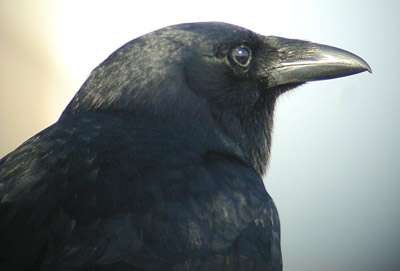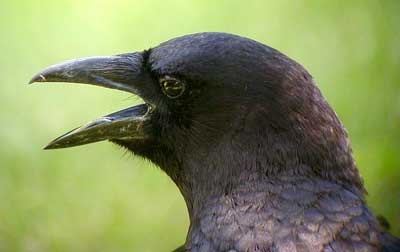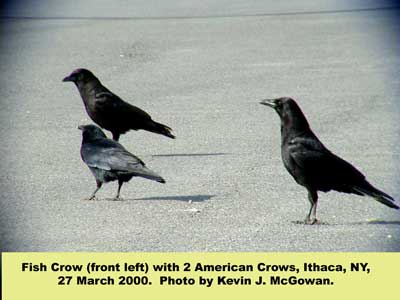
How do you tell a

Fish Crow Corvus ossifragus
from an
American Crow Corvus brachyrhynchos?
 |
How do you tell a |
 |
Fish Crow Corvus ossifragus |
from an |
American Crow Corvus brachyrhynchos? |
Fish Crows (Corvus ossifragus) are a rather small species of crow endemic to the Southeastern United States. Typically they have been restricted to the coastline from southern New England to Texas, but in the last few decades have been expanding their range, especially inland up large rivers.
Visually, Fish Crows are difficult to tell from American Crows. Unless one has a great deal of experience in close observation of the species, identification is only safely done by voice.
The calls of Fish Crows and American Crows are readily told apart. American Crows most frequently give the familiar "caw-caw." (This 222kb recording can be found on the Lab of O Bird of the Week page)." Fish Crows have a much more nasal call that may be better enumerated "awh" or "uhn." The most diagnostic call of the Fish Crow is the double noted "uh-uh." I always say that if you want to tell the species of crow, ask it if it is an American Crow. Fish Crows will deny this by their emphatic "uh-uh!"
To hear what Fish Crows sound like, try this recording (294kb wav file) of a couple of Fish Crows calling in Florida (Macaulay Library of Natural Sounds # 26627). This cut does not contain the distinctive 2-note call, but has a number of other calls in it. Another example of a single note from an Ithaca, NY Fish Crow can be heard here (67kb) (MLNS 27105).
Fish Crow calls can be confused with the begging calls of American Crows.
It should be pointed out that these begging calls are given not just by dependent young crows, but also by adult crows in certain situations.
Most prominently, early in the breeding cycle of American Crows the females will give begging calls frequently. These calls usually are given from the nest when the female is beginning to incubate, but can be given away from the nest too. (It is sort of a reminder to the rest of the family that she is going to be spending all her time the next few weeks on the nest and will need them to feed her.) In Ithaca, NY, this type of adult begging call peaks around the first week in April, but can be heard from the last week of March until mid-May. A 628kb wav file of a female American Crow doing the incubation-start call can be accessed here. This recording was made in Ithaca, NY in April 2001 and is of a female calling from her nest. This example sounds a bit more American Crow "caw"-like than is typical. (The female was not typical either. She called continuously from the nest for weeks instead of the day or two that is most common.) The spacing is normal, though.
Nestling crows don't beg all that much, but once they come out of the nest (around 5 weeks old) they beg quite a bit. The young are fed by the families for over a month or two out of the nest, and the young will still beg at adults even though they are not being fed. So, figure the peak of fledging in Ithaca is the end of May, and young crows will be begging until July. The few late renests (after an early failure) can drag this into August. The confusing calls are not so much juvenile calls as they are begging calls. It's just that juveniles don't talk about much except getting fed. They actually do a lot of soft notes, but these are difficult to hear. They don't start doing the adult "caw caw" territorial stuff until late in the summer. By then they are pretty much nutritionally independent and not begging much. It is possible to tell a juvenile's caw from an adult caw, but you wouldn't confuse it with a Fish Crow.
Other times that you might hear the begging notes are during interactions between a dominant and a subordinate, when the subordinate begs to the dominant. These encounters are infrequent throughout the year.
The begging calls of the American Crow and the normal calls of the Fish Crow, although rather similar, can generally be distinguished by their construction. The overall quality and tone of the two are about the same. American Crow begs, however, are generally of longer duration and do not have the same abrupt ending that Fish Crows calls do. Think of if as "aaawwwwww" versus "aawwp". The American Crow begging call also often drops in pitch slightly at the end, which the Fish Crow call does not. American Crows never give the double noted "uh-uh" call that is so typical of Fish Crows in most areas. And Fish Crow calls are never terminated by the higher pitched gobbling notes that often end an American Crow's begging bout when it is fed.
I might also point out that members of the Corvidae can be accomplished mimics. I used to have a Fish Crow in my Tampa, FL neighborhood that did a nearly perfect American Crow "caw." So it is possible in areas where they both occur that both could occasionally mimic the other. That would probably be infrequent, though, so I wouldn't worry about it much.
Physical Characters
Telling the two species apart visually is very difficult. After thousands of hours of looking at crows, I think I am accurate in my visual ID to species only about 80% of the time.
Both species are all black and similarly proportioned, but physical differences do exist:
Fish Crows are substantially smaller than American Crows. On average Fish Crows weigh 270-300 grams versus 500 grams for American crows. But the size difference is difficult to detect, even when both species are present together. Only when the two are side by side is the size difference apparent.

Fish Crows are a bit more glossy purple, but this difference is very difficult to detect.
Fish Crows have more slender bills and feet than American Crows. (Foot size is especially noticeable when contrasted against the large-footed south Florida race of the American Crow, C. b. pascuus.) But bill size varies quite a bit in American Crows, with males having larger bills. A small billed female American Crow can have the same look in the face as a Fish Crow.
Fish Crows show a shorter legged look when walking on the ground. The "thigh" (actually the tibiotarsus) shows less prominently than is typical with an American Crow.
The feathers on the upper back of American Crows show a decidedly "ringed" or "scaled" effect not shown by Fish Crows. This character is especially obvious when the crow is between the sun and the observer. The upper back feathers of Fish Crows are more lax at the tips (without barbs holding them together), and consequently the upper back is without rings. In fact, on the upper back no individual feathers can be distinguished. See if you can detect this difference on the head shots at the top of the page. (The exposure of the shots is very different, but the effect is still there.)
The "Wing Formula" differs between the species. The outermost primaries on the wings are of different proportions. On a bird in the hand these can be measured easily, but they are not easily seen in the field. Primaries (the feathers that come out of the hand part of the wing) are numbered starting from the inside of the wing, and in crows the outermost one is primary number 10. In Fish Crows, the 9th primary (p9) is the same size as, or is slightly longer than the 5th primary (p5), while in American Crows p5 is markedly longer than p9. The effect of this differences is that the Fish Crow wing is somewhat more pointed in appearance.
This difference is hard to see in the field and is not definitive. It should be used as an indication only. Molt and individual wear can give misleading impressions.
Fish Crows have a faster wingbeat than American Crows. In an area where both species occur the difference in wingbeat frequency can be an indication of the species, but this is not a definitive character. Not all crows of a given species fly at the same wingbeat rate. Juvenile and yearling American Crows usually fly with a faster beat rate than do adults (just not as efficient fliers?), and molt or feather wear can affect the rate too. And sometimes crows are just more in a hurry than at other times.
Fish Crows use a different posture for calling than American Crows.
Fish Crows tend to stay more hunched and shorter necked, and typically fluff their throat feathers, as shown by this Ithaca bird.
American Crows tend to stretch their necks a bit, and do not substantially fluff their throat feathers.
The shape and fluffed throat can be detected even in this blurry shot of an Ithaca Fish Crow calling.
Fish Crows often have a sharp hook to the end of the upper bill. I'm not too certain about this one, but I noticed that several Fish Crows I handled recently had a very pronounced hook. Individual crows vary a great deal in this character, so I'd be careful. This adult Fish Crow was captured in Ithaca, NY in Feb 2001 and shows what seems to be a typical amount of hook to the tip of the bill. This SY, probably female American Crow captured in Ithaca in March 2001 shows a rather long extension of the upper bill, but it is not nearly as hooked as the Fish Crow.
American Crows molt earlier than Fish Crows. During the summer the two species can be distinguished by their stages of molt. In much of their range American Crows breed a month or more earlier than Fish Crows (Johnston 1961, The biosystematics of American crows, Univ. of Washington Press; Clapp and Banks 1993, Raven 64: 90-98; McGowan 2001, Fish Crow (Corvus ossifragus) in Birds of North America, No. 589). In upstate New York American Crows start incubation the first week of April, while Fish Crows don't start until May. Most birds do not molt until they are finished breeding, and the molting schedules of the two crows reflect the month difference in their breeding schedule. The earliest Ithaca American Crows (non-breeders and those whose nests have failed) will start molting in June and will be finished by the end of September. Ithaca Fish Crows, on the otherhand, start molting in late July and don't finish until October.
Return to the Bad Photos page.
Return to Kevin McGowan's home page.
Go to the Crow Page.
Revised: April 06, 2005.